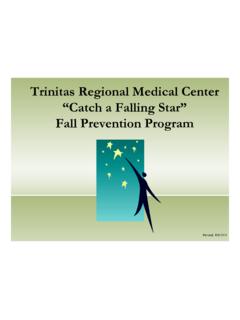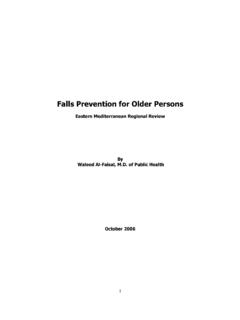Transcription of WHo Global report on falls Prevention in older Age
1 PAGE 1 AGEin G And LifE CoursE, fAmiLy And Community HEALtHWHo Global report on falls Prevention in older AgeAGEin G And LifE CoursE, fAmiLy And Community HEALtHWHo Global reporton falls Prevention in older AgePAGE iiDesign: Marilyn Langfeld/Art Director, Adina Murch/Design, Ann Feild/Didyk illustrationWHO Library Cataloguing-in-Publication DataWHO Global report on falls Prevention in older falls - Prevention and control. factors. 3. Population dynamics. Health 978 92 4 156353 6 (NLM classification: WA 288) World Health Organization 2007 All rights reserved. Publications of the World Health Organization can be obtained from WHO Press, World Health Organization, 20 Avenue Appia, 1211 Geneva 27, Switzerland (tel.: +41 22 791 3264; fax: +41 22 791 4857; e-mail: Requests for permission to reproduce or translate WHO publications whether for sale or for noncommercial distribution should be addressed to WHO Press, at the above address (fax: +41 22 791 4806; e-mail: The designations employed and the presentation of the material in this publication do not imply the expression of any opinion whatsoever on the part of the World Health Organization concern-ing the legal status of any country, territory, city or area or of its authorities, or concerning the delimitation of its frontiers or boundaries.))
2 Dotted lines on maps represent approximate border lines for which there may not yet be full mention of specific companies or of certain manufacturers products does not imply that they are endorsed or recommended by the World Health Organization in preference to others of a similar nature that are not mentioned. Errors and omissions excepted, the names of propri-etary products are distinguished by initial capital reasonable precautions have been taken by the World Health Organization to verify the information contained in this publication. However, the published material is being distributed without warranty of any kind, either expressed or implied. The responsibility for the interpreta-tion and use of the material lies with the reader. in no event shall the World Health Organiza-tion be liable for damages arising from its in FrancePAGE iWHO Global report ON falls Prevention iN older AGEC ontentsChapter IMagnitude of falls A worldwide overview 11.
3 falls 12. Magnitude of falls worldwide 13. Population ageing 34. Main risk factors for falls 45. Main protective factors 66. Costs of falls 67. References 7 Chapter IIActive ageing: A Framework for the Global Strategy for the Prevention of falls in older age 101. What is 'Active Ageing'? 102. References 12 Chapter IIID eterminants of Active Ageing as they relate to falls in older age 131. Cross-cutting determinants: Culture and gender 13 2. Determinants related to health and social services 143. Behavioural determinants 154. Determinants related to personal factors 165. Determinants related to the physical environment 18 6. Determinants related to the social environment 187. Economic determinants 198. References 19 Chapter IVChallenges for Prevention of falls in older age 201. Changing behaviour to prevent falls 202. References 25 Chapter VExamples of effective policies and interventions 261 Policy 262. Prevention 293. Practice Interventions 324.
4 Concluding remarks 335. References 33 Chapter VIWHO falls Prevention model within the Active Ageing framework 351. The need 35 2. The foundation 373. Three pillars of the WHO falls Prevention Model 394. The way forward 47 PAGE iiAcknowledgementsThis Global report is the product of the conclusions reached and recommenda-tions made at the WHO Technical Meeting on falls Prevention in older Age which took place in victoria, Canada in February 2007. The report includes international and regional perspectives on falls Prevention issues and strategies and is based on a series of background papers that were prepared by worldwide recognized ex-perts. The papers are available at: report was developed by the Department of Ageing and Life Course (ALC) under the direction of Dr Alexandre Kalache and the coordination of Dr Dongbo Fu who was closely assisted by Ms Sachiyo Yoshida. ALC would like to thank three institutions for their financial and technical support: the Division of Aging and Seniors, Public Health Agency of Canada; the Department of Healthy Children, Women and Seniors, British Columbia Ministry of Health and the British Columbia injury Prevention and Research contribution and input of the following experts are gratefully acknowledged: Dr W.
5 Al-Faisal (Syria), Ms Lynn Beattie ( ), Dr Hua Fu (China), Dr K. James (Jamaica), Dr S. Kalula (South Africa), Dr B. Krishnaswamy (india), Dr Nabil Kronfol (Lebanon), Dr P. Marin (Chile), Dr ian Pike (Canada), Dr Debra J. Rose ( ), Dr vicky Scott (Canada), Dr Judy Stevens ( ), Prof. Chris Todd (the United Kingdom), Dr G. Usha ( india ) and Dr Wojtek J. Chodzko-Zajko ( ). Editing, layout and printing of the report was managed by Mrs Carla Salas-Rojas (ALC).PAGE 1 WHO Global report ON falls Prevention iN older AGEC hapter i. Magnitude of falls A worldwide overview1. FallsFalls are prominent among the exter-nal causes of unintentional injury. They are coded as E880-E888 in International Classification of Disease-9 (ICD-9), and as W00-W19 in ICD-10, which include a wide range of falls including those on the same level, upper level, and other unspecified falls . falls are commonly defined as in-advertently coming to rest on the ground, floor or other lower level, excluding inten-tional change in position to rest in furni-ture, wall or other objects.
6 A) Problems in defining adoption of a definition is an important requirement when studying falls as many studies fail to specify an operational definition, leaving room for interpretation to study participants. This results in many different interpretations of falls . For example, older people tend to describe a fall as a loss of balance, whereas health care professionals generally refer to events leading to injuries and ill health (1). Therefore, the operational definition of a fall with explicit inclusion and exclusion criteria, is highly Magnitude of falls worldwidea) Frequency of 28-35% of people aged of 65 and over fall each year (2-4) increasing to 32-42% for those over 70 years of age (5-7). The frequency of falls increases with age and frailty level. older people who are living in nursing homes fall more often than those who are living in community. Approximately 30-50% of people living in long-term care institutions fall each year, and 40% of them experienced recurrent falls (8).
7 The incidence of falls appears to vary among countries as well. For instance, a study in the South-East Asia Region found that in China, 6-31% (9-13) while another, found that in Japan, 20% (14) of older adults fell each year. A study in the Region of the Americas (Latin/Caribbean region) found the proportion of older adults who fell each year ranging from in Barbados to 34% in Chile (15).b) Fall injury rates. The rate of hospital admission due to falls for people at the age of 60 and older in Australia, Canada and the United Kingdom of Great Britain and Northern Ireland (UK) range from to per 10 000 population. Fall injury rates resulting in emergency department visits of the same age group in Western Australia and in the United Kingdom are higher: per 10 000 population total. PAGE 2c) Need of medical attention. falls and consequent injuries are major public health problems that often require medical attention. falls lead to 20-30% of mild to severe injuries, and are underlying cause of 10-15% of all emergency depart-ment visits (18).
8 More than 50% of injury-related hospitalizations among people over 65 years and older (19). The major underlying causes for fall-related hospital admission are hip fracture, traumatic brain injuries and upper limb injuries. The duration of hospital stay due to falls varies; however it is much longer than other injuries. It ranges from four to 15 days in Switzerland (20), Sweden (21), USA (22), Western Australia (23), Province of British Columbia and Quebec in Canada (24). In the case of hip fractures, hospital stays extend to 20 days (25). With the increas-ing age and frailty level, older person are likely to remain in hospital after sustaining a fall-related injury for the rest of their life. Subsequently to falls , 20% die within a year of the hip fracture (26). In addition, falls may also result in a post-fall syndrome that includes dependence, loss of autonomy, confusion, immobiliza-tion and depression, which will lead to a further restriction in daily ) Fall mortality account for 40% of all injury deaths (27).
9 Rates vary depending on the country and the studied population. Fall fatality rate for people aged 65 and older in United States of America (USA) is per 100 000 population ( for men and for women) (28) whereas in Canada mortality rate for the same age group is per 10 000 population (29). Mortality rate for people age 50 and older in Finland is for men and for women per 100 000 population (30). Figure 1 (page 3) shows fatal falls by 5-year age group and sex (31). Fatal falls rates increase exponentially with age for both sexes, highest at the age of 85 years and over. Rates of fatal falls among men exceed that of women for all age groups in spite of the fewer occurrences of falls among them. This is attributed to the fact that men suffer from more co-morbid conditions than women of the same age (28). A similar difference in mortality between men and women has been reported following hip fracture. The incidence of hip fracture is greater among women while hip fracture mortality is higher among men (32).
10 One study found that men reported poorer health and a greater number of underlying conditions than women, which substan-tially increased the impact of hip fracture and consequently increased the risk of mortality (33). Or is it not that men who fall have more co-morbidity than other men in 3 WHO Global report ON falls Prevention iN older AGE3. Population ageing"Population ageing is a triumph of human-ity but also a challenge to society" (34). Worldwide, the number of persons over 60 years is growing faster than any other age group. The number of this age group was estimated to be 688 million in 2006, projected to grow to almost two billions by 2050. By that time, the population of older people will be much larger than that of children under the age of 14 years for the first time in human history. Moreover, the oldest segment of population, aged 80 and over, particularly prone to falls and its consequences is the fastest growing within older population expected to represent 20% of the older population by 2050 (35).














